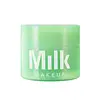What's inside
What's inside
 Key Ingredients
Key Ingredients

 Benefits
Benefits

 Concerns
Concerns

 Ingredients Side-by-side
Ingredients Side-by-side

Glycine Soja Oil
EmollientHelianthus Annuus Seed Oil
EmollientLauryl Laurate
Skin ConditioningPolyglyceryl-10 Dioleate
EmulsifyingPolyglyceryl-2 Sesquicaprylate
EmulsifyingSynthetic Wax
AbrasiveRicinus Communis Seed Oil
MaskingStearyl Behenate
EmollientCannabis Sativa Seed Extract
EmollientCarthamus Tinctorius Seed Oil
MaskingAloe Barbadensis Extract
Skin ConditioningHydrogenated Castor Oil
EmollientAgave Tequilana Leaf Extract
AstringentPrunus Avium Flower Extract
Skin ConditioningTocopherol
AntioxidantSilica
AbrasiveOctyldodecanol
EmollientSorbitan Oleate
Emulsifying1,2-Hexanediol
Skin ConditioningSodium Hyaluronate
HumectantCaprylyl Glycol
EmollientParfum
MaskingCitral
PerfumingCI 77891
Cosmetic ColorantGlycine Soja Oil, Helianthus Annuus Seed Oil, Lauryl Laurate, Polyglyceryl-10 Dioleate, Polyglyceryl-2 Sesquicaprylate, Synthetic Wax, Ricinus Communis Seed Oil, Stearyl Behenate, Cannabis Sativa Seed Extract, Carthamus Tinctorius Seed Oil, Aloe Barbadensis Extract, Hydrogenated Castor Oil, Agave Tequilana Leaf Extract, Prunus Avium Flower Extract, Tocopherol, Silica, Octyldodecanol, Sorbitan Oleate, 1,2-Hexanediol, Sodium Hyaluronate, Caprylyl Glycol, Parfum, Citral, CI 77891
 Reviews
Reviews

Alternatives
Ingredients Explained
These ingredients are found in both products.
Ingredients higher up in an ingredient list are typically present in a larger amount.
Carthamus tinctorius seed oil comes from safflower, one of humanity's oldest crops.
Safflower seed oil contains a high percentage of linoleic acid and oleic acid. It also contains Vitamin E. These three components are effective moisturizers.
Vitamin E helps nourish your skin's lipid barrier. It is also a potent antioxidant. Antioxidants help fight free-radical molecules, or unstable molecules that may damage your skin cells.
Due to its high fatty acid content, this ingredient may not be malassezia folliculitis safe.
Thoughout history, safflower has been used for dying fabrics and in food as a saffron substitute.
Learn more about Carthamus Tinctorius Seed OilTocopherol (also known as Vitamin E) is a common antioxidant used to help protect the skin from free-radicals and strengthen the skin barrier. It's also fat soluble - this means our skin is great at absorbing it.
Vitamin E also helps keep your natural skin lipids healthy. Your lipid skin barrier naturally consists of lipids, ceramides, and fatty acids. Vitamin E offers extra protection for your skin’s lipid barrier, keeping your skin healthy and nourished.
Another benefit is a bit of UV protection. Vitamin E helps reduce the damage caused by UVB rays. (It should not replace your sunscreen). Combining it with Vitamin C can decrease sunburned cells and hyperpigmentation after UV exposure.
You might have noticed Vitamin E + C often paired together. This is because it is great at stabilizing Vitamin C. Using the two together helps increase the effectiveness of both ingredients.
There are often claims that Vitamin E can reduce/prevent scarring, but these claims haven't been confirmed by scientific research.
Learn more about Tocopherol